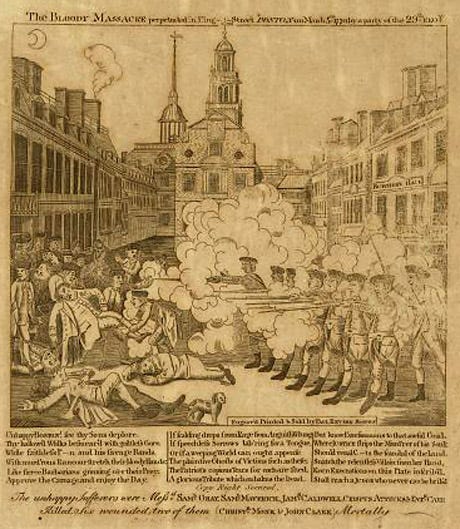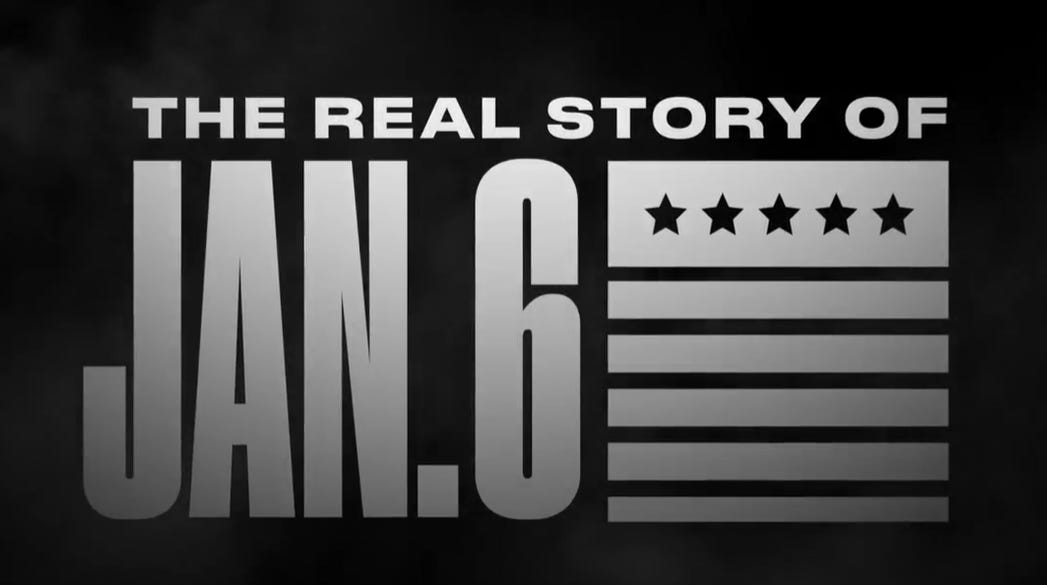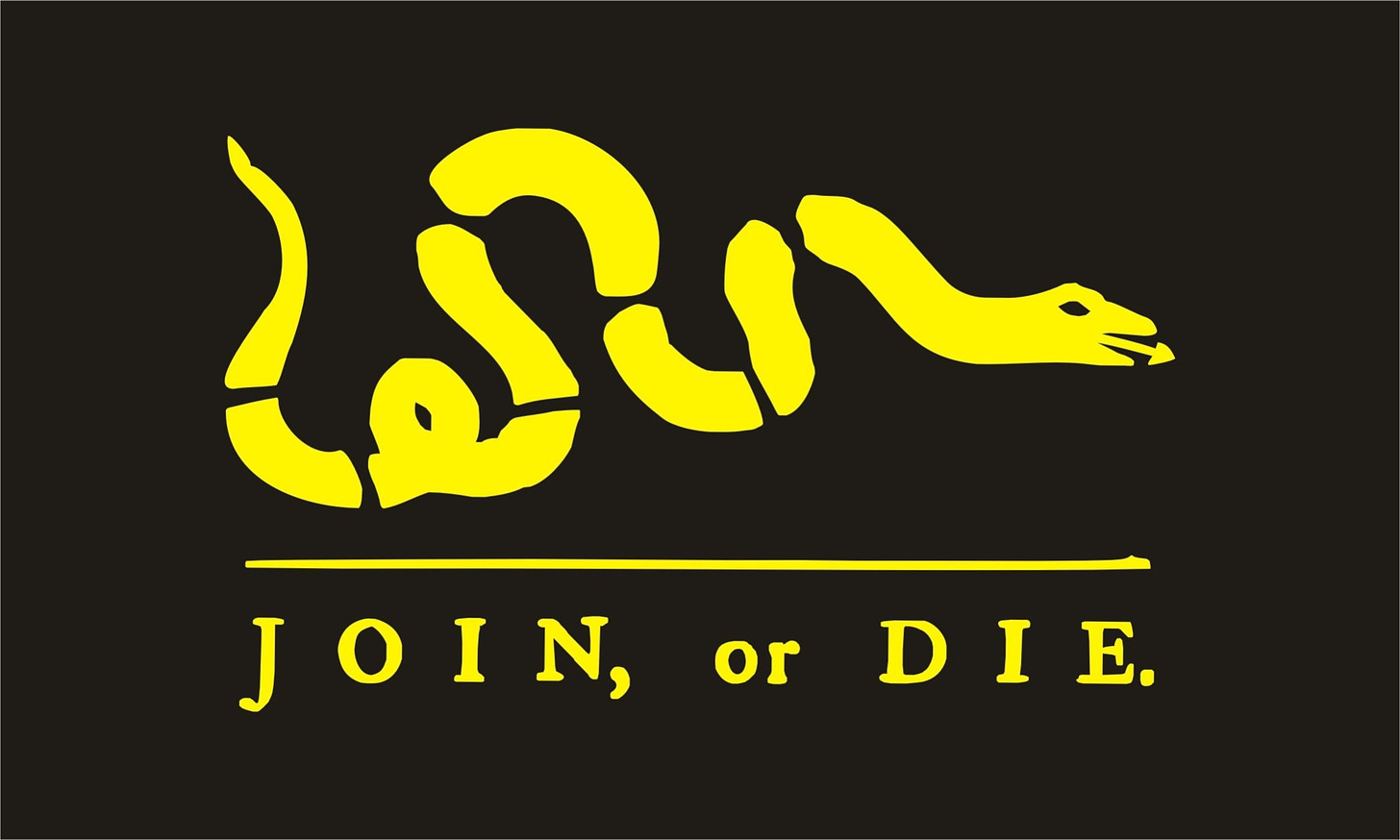Special Edition - Boston Massacre Lesson Learned!
Reviewing the details of the 1770 Boston Massacre, it gives us insight into the events of January 6, 2021. Today, we see our Constitution as a bloody remnant.
On that night the formation of American independence was laid… Not the battle of Lexington or Bunker Hill, not the surrender of Burgoyne or Cornwallis were more important events in American history than the battle of King Street on March 5 1770.
John Adams
Foreword
Reviewing the details of the 1770 Boston Massacre gives us insight into the events of January 6, 2021. With that analysis, we see our Constitution as a bloody remnant. Never ignore past history otherwise, we face damnation. Remember the operative words for this special edition of Frederick R. Smith Speakes: fairness, objectivity, snitching, and propaganda.
For the opening salvo, eighty-six the Nasty New World Order. Fellow non-collectivist Americans: Unite or Die!
Boston March 5, 1770
Shortly after 9:00 am on March 5, 1770, in Boston, Massachusetts, a church bell began to toll the alarm for fire. Crowds came pouring into the streets. Meanwhile, a small group of youngsters and men taunted a British century posted outside the Customs House. A crowd of several hundred converged at the Customs House. Seven British soldiers reinforced the lone guard.
The crowd tossed chunks of ice, stones, and oyster shells at the despised redcoats. Shouting and cursing, the group faced the gunfire of the redcoats. With five men killed, Samuel Adams called the killings a “bloody butchery.” He distributed a vivid print published by Paul Revere depicting the incident as the “Bloody Massacre.” Better known as the “Boston Massacre,” the image shows British tyranny.
Among those killed by the British, the first victim was a middle-aged sailor and rope-maker. Accounts suggest it was Crispus Attucks, of mixed descent (African American and American Indian). History marks Attucks as one of the first martyrs of the struggle for American independence. He also gives us a symbol of African Americans’ struggle for freedom and equality.
On March 6, the British military asked 34-year-old John Adams to defend the soldiers and their captain. They informed Adams that no one else would take the case. Adams favored the colonist’s cause but, based on principle, accepted the case. He believed that nobody should face denial of the right to counsel and a fair and objective trial. He knew taking the case would risk his reputation as a lawyer. While sounding self-righteous, Adams was also being honest. Of note, twelve British soldiers and Captain Preston faced arrest. But only eight faced trial in October 1770. Some felt that the other four shot into the crowd from the window of the Customs House. Forensics never confirmed that element.
In 1769, the year before, Adams had defended four American sailors charged with killing a British naval officer in step with widespread outrage. The officer boarded their ship with a detachment of men to force them into military or naval service. The court acquitted the sailors as they acted in self-defense.
Taking on the case of the Bloody Massacre, redcoats placed Adams in the crosshairs of the colonists. He worried for his wife, Abigail, who was pregnant. Because of the fever-pitch emotions of the Bostonians, Adams feared he was risking his family’s safety as well as his own. The rumor mills regurgitated the falsehood that he took a bribe to take the case. The only payment Adams got was a retainer of eighteen guineas.
For Adams, the public scorn was painful in the extreme. “The only way to compose myself and collect my thoughts,” he wrote in his diary, “is to set down at my table, place my diary before me, and take my pen into my hand. This apparatus takes off my attention from other objects. Pen, ink, and paper and a sitting posture are great helps to attention and thinking.” Adams had studied Italian penologist and opponent of capital punishment, Cesare Marchese di Beccaria. During the trial, he quoted the following from di Beccaria:
If, by supporting the rights of mankind, and of invincible truth, I shall contribute to save from the agonies of death one unfortunate victim of tyranny, or of ignorance, equally fatal, his blessings and years of transport will be sufficient consolation to me for the contempt of all mankind.
Adams defended the redcoats in two trials at the new Queen Street Courthouse in Boston. The first trial occurred in October when passions had cooled. There, Adams defended the British captain, Thomas Preston.
Young Josiah Quincy, Jr., assisted Adams. The court-appointed lawyer trying the case was Josiah’s brother, Samuel, assisted by Robert Treat Paine. After the Massacre, many believed that Captain Preston was the one who gave the order to fire on the crowd. The famous engraving by Paul Revere even shows him raising his hand in command. However, testimony proved he stood in the line of fire between the guns and the mob. Accounts indicate that Adams’s argument for the defense was par excellence. Thus, the jury found Captain Preston not guilty.
On December 3, the soldiers faced a more extended two-day trial. Adams’s closing, written down by attendees, affected the crowded courtroom in an “electrical” atmosphere. He began with “I am for the prisoners at bar,” and then invoked the line from the Marchese di Beccaria (see above). A detailed study of the facts convinced Adams of the innocence of the soldiers as he felt the mob brought on the tragedy. The mob was the result of the flawed policy of stationing troops in a city with the pretext of keeping the peace:
We have entertained a great variety of phrases to avoid calling this sort of people a mob. Some call them shavers, some call them geniuses. The plain English is, gentlemen, [it was] most probably a motley rabble of saucy boys, Negroes and mulattoes, Irish teagues and outlandish jacktars. And why should we scruple to call such a people a mob, I can’t conceive, unless the name is too respectable for them. The sun is not about to stand still or go out, nor the rivers to dry up because there was a mob in Boston on March 5 that attacked a party of soldiers. . . . Soldiers quartered in a populous town will always occasion two mobs where they prevent one. They are wretched conservators of the peace.
Adams described the pelting of the soldiers with “every species of rubbish” and the mantra “Kill them! Kill them!” He recounted how one soldier faced clubbing down and then hit again as soon as he could rise. Adams asked, “Do you expect he should behave like a stoic philosopher, lost in apathy?” Self-defense was the primary canon of the law of nature. He stated, “The reason is, because it’s of more importance to community, that innocence should be protected, than it is, that guilt should be punished.” In his famous quip of “Facts are stubborn things,” focusing on the jury, he also said, “and whatever may be our wishes, our inclinations, or the dictums of our passions, they cannot alter the state of facts and evidence.”
In two and a half hours, the jury decided the fate of the eight soldiers. The result: six acquittals and two guilty of manslaughter, for which faced punishment by branding ‘M’ on their thumbs. That prevented the use of the same defense in the future.
After the trials, Adams faced scorn in the Boston Gazette. He claimed to have suffered the loss of more than half his practice. Samuel Adams appears never to have objected to Adam’s defense of the redcoats. Samuel Adams likely approved due to his respect for John’s fierce integrity. In time Adams’s part in the trials increased his public standing. In old age, he recounted his defense of the redcoats as “one of the most gallant, generous, manly and disinterested actions of my whole life, and one of the best pieces of service I ever rendered my country.”
As additional background, Christopher Seider (or Snider) was a young boy considered the first American killed in the American Revolution. A fight between the mob and the British loyalists flared up by throwing rocks at the shop of a Loyalist merchant. Christopher was 11 years old when he was shot and killed by loyalist Ebenezer Richardson in Boston on February 22, 1770. His funeral became a major political event, with his death heightening tensions that erupted into the Boston Massacre on March 5, 1770.
Think Boston Massacre: fairness, objectivity, snitching, and propaganda.
Washington DC, January 6, 2021
Today, we hear unrelenting and filtered accounts (propaganda) of the events surrounding January 6, 2021 (J6). Legacy media projects a never-ending program of one side of the story. While alternate media may give us “the other side” of the story, my affection for early American history prompted me to write this essay. We can learn from John Adams, who said, “Facts are stubborn things.” Fact: my relationship with people who have first-hand knowledge of J6 compelled me to share this reflection.
As a risky admission, several of my friends were in DC on January 6, 2021. None of them entered the Capitol but saw the events from a distance. One buddy has related a communist-like threat where one of his friends threatened to call the FBI to rat on him for being at the rally. I do not use the term “communist-like” smugly, but it is an appropriate description. Please let me explain.
Recently, I had the honor and privilege of meeting a young Cuban man of 35 who, in early 2022, was lucky to enter our Nation. He is proud to have a green card. There is so much more about the good plans of this remarkable young man. Out of precaution, none offered here to protect his future. As we know, there are reasons why Cubans have a hard time getting to America while others can walk right through the southern border. I will use the name fictitious name of Juan.
My friend Juan confirmed what we already know about the bad of collectivism. Specifically, collectivism provides the Cubans with bad medical care and limited junk products. That is just the creature’s surface. Despite what the collectivists project here, like in Canada, Juan said socialized medicine is “el-Crapo.” Despite being an island nation, nationalized businesses limit the availability of fish for Cubans to eat. According to Juan, the two things that collectivists do well are 1) propaganda and 2) snitching. Think J6: fairness, objectivity, snitching, and propaganda.
An even more startling encounter with an extremely wealthy and prominent person lit a fire in my persona. This person, who will go unnamed, pontificated to me, “Those who participated in J6 should all face hanging in public.” Ergo, the Boston Massacre defendants faced better treatment than the J6 political prisoners.
As close friends know, Fred was never a big fan of Trump. Yet, many of Trump’s policies were good for the Nation. Speakes readers realize the numbing legacy “narrative” relating to J6, but my personal experiences compelled me to offer this essay as a historical reflection. Thus, I also provide the following counter information. The documentary “Bloody Hill” provides a holistic view of J6.
We also know nefarious collectivists such as Antifa members got a pass for burning, looting, and mayhem over the past three years. Since this essay does not give an account of all the people caught up in the J6 chaos, please review 723 Days After Jan. 6, 2021. As you will discover, many participants face the cancellation of their constitutional rights. Please read the write-up “Don’t Do Nothing” by J6 political prisoner Jeremey Brown. As a backup, below is a PDF copy:
From a Constitutional perspective, here are the pivotal elements of Jeremey’s letter:
As I wrote this account on December 30, 2021, I mark my 92nd day of being held in the maximum security section of the Pinellas County Jail as an FBI whistleblower and Political Prisoner. To date, these are the crimes the FBI and Department of Justice are guilty of committing under Title 18 US Code, Section 242, Deprivation of Rights under Color of Law:
Violations of Article 1 of the Bill of Rights by criminalizing Free Speech and peaceful assembly for attending a permitted rally on public grounds.
Violations of Article 2 of the Bill of Rights by passing and enforcing unconstitutional gun laws that violate the letter and intent of the “shall not be infringed” clause.
Violations of Article 4 of the Bill of Rights by deceptively obtaining an unreasonable and illegal search warrant by lying to the issuing judge. When asked by me and my girlfriend to produce the warrant at the time of arrest, they refused. One agent was even recorded stating, “We don’t know what we are looking for…yet.” They should look for a copy of the Constitution and read it.
Violations of Article 5 of the Bill of Rights by not reading me my rights prior to arrest and questioning. They are currently still depriving me of my life, liberty and property without due process of law.
Violations of Article 6 of the Bill of Rights by making sure nothing is speedy, attempting to deny me access to any of the evidence against me, by denying my right to a public trial by claiming everything is “sensitive” or “highly sensitive,” yet leaking information to media outlets such as the Daily Beast who had my search warrant before I did. They are denying me the right to “face my accusers” by citing numerous “unnamed witnesses,” many likely to be FBI informants. Because I am locked away in jail, I do not have complete access to witnesses in my favor and all my contacts with legal counsel are on monitored systems. So far I have been denied access to my attorney six times due to “COVID.”
Most egregious are the violations of Article 8 of the Bill of Rights by denying me bond and keeping me locked in maximum security.
The Real Story of January 6, a documentary by Epoch Times, provides further evidence counter to the narrative.
The above notwithstanding, of course, I would never condone trespassing or breaking into government or private buildings as part of any protest. The anarchists Antifa and fellow travelers do such things and commit violence with impunity.
Think J6: fairness, objectivity, snitching, and propaganda.
Afterword
During the drafting of this essay, a man “allegedly” (a video shows the attack) tried to stab a Republican candidate for New York governor, Lee Zeldin, with a bladed weapon during a campaign stop on July 21, 2022. Just as Zeldin predicted, authorities released the assailant from jail within hours of his arrest on a felony charge. Think of the outcome if somebody from the other party faced such an attack (attempted murder).
We live in extraordinary times. The J6 government show “trial” is the tip of the iceberg. Meanwhile, Antifa and fellow travelers constitute a big lie because they proclaim themselves “anti-fascist.” That caustic band of collectivists promotes the very thing they protest — the fusion of government and woke businesses. That partnership is a particularly nasty form of collectivism — fascism. Moreover, Antifa is known to goose-step with authorities to defend drag shows and go after moms who exposed drag queen storytime.
Our “leaders” now deem the defense of the Constitution as domestic terrorism. Think about it all: fairness, objectivity, snitching, and propaganda.
God save our country.
It may be too late, as the system will crash. Be like John Adams, don’t get ready, be ready. Non-collectivists (real conservatives, real constitutionalists, libertarians, and classical liberals): Unite, or Die.
Author and publisher, Frederick R. Smith
Sources
John Adams, David McCullough, 752 pages, Simon & Schuster, May 2001









Excellent history lesson. Skillful connection of then and now and the similarities. Same theme though. You have to stand for what is right no matter what.
Retired Green Beret, Ex-Military Contractor & Entrepreneur Gets Rude Awakening When His Former Employer The FBI Designates Him & His Organization "Domestic Terrorist https://2ndsmartestguyintheworld.substack.com/p/retired-green-beret-ex-military-contractor